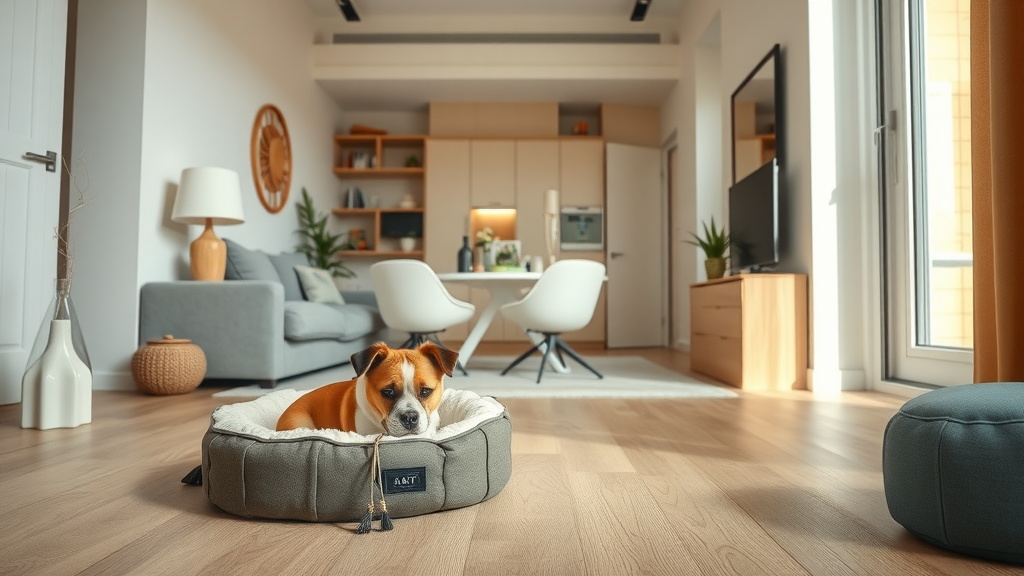Did you know 98% of pet owners seek pet-friendly apartments in Charlotte ? In today’s thriving Queen City rental market, finding a friendly apartment tailored for both you and your furry companions isn’t just a preference—it’s a necessity. Imagine coming home every day to a space that welcomes wagging tails and purring friends just as warmly as it welcomes you. In this definitive guide, we break down everything you need to know about pet-friendly apartments Charlotte offers, so you and your pets will truly feel at home.
98% of Pet Owners Want Pet-Friendly Apartments in Charlotte
The desire to find pet-friendly apartments Charlotte has skyrocketed, with nearly every renter who owns a pet prioritizing spaces where their animals are not just allowed but celebrated. The growing trend has prompted property managers to roll out enhanced amenities, flexible pet policies , and even organize pet socials. These adjustments are not just about keeping up with the times but about building inclusive communities where every member—regardless of species—can thrive. For example, modern communities like those in university city or South End blend dog parks, walking trails, and grooming stations into their offerings, making it easier than ever to find the perfect place. Whether you’re searching for apartments for rent or luxury pet friendly apartments , your furry friend is sure to feel right at home in Charlotte.

- What you’ll discover in finding pet-friendly apartments in Charlotte:
- Best pet-friendly apartments Charlotte has to offer
- Amenities designed for your pets
- Lease terms and policies for pet friendly apartments
- Tips for securing your pet’s perfect home
- Top neighborhoods for pet-friendly living
Understanding the Demand for Pet-Friendly Apartments Charlotte
Charlotte’s reputation for pet-friendly parks, vibrant neighborhoods, and walkable city spaces has propelled demand for friendly apartments for rent that specifically cater to pets and their owners. The city’s demographics reveal a younger, dynamic workforce and families with a penchant for pet ownership, fueling this surge. Whether it’s for a dog park , pet washing station, or simply generous green spaces, these features are now expected as standard in modern apartments for rent .
The substantial increase in the number of pet owners over the past decade, especially millennials and Gen Z renters, has changed the way apartment search and building design occur in Charlotte. Landlords who adapt to these changing needs, adding pet-centric amenities alongside in-demand features like a fitness center , stainless steel appliances , in-unit washers, and community spaces, consistently attract responsible, long-term tenants seeking a place for themselves and their pets.
Rise of Friendly Apartments for Rent in Charlotte
Over the past few years, the city has seen a rise in purpose-built, pet friendly apartments that offer far more than just permission for small breeds. Newer developments create community courtyards, host pet adoption events, and dedicate staff to support resident four-legged friends. The continued popularity of dog parks and pet meet-ups at these properties has fostered stronger neighborhood bonds, making them ideal for both pet owners and prospective renters.
Today's friendly apartments for rent often include innovative features such as pet spas, dog runs, and even on-site trainers. Residents can gather for community pet socials, making friends while their animals play. These modern conveniences transform everyday living, turning a simple apartment into a welcoming, multifaceted home for all.

What Makes an Apartment Truly Pet Friendly
A pet-friendly apartment goes beyond a simple “pets allowed” sign on the leasing office door. These apartments are thoughtfully designed to meet the needs of pets and their owners, featuring easy-to-clean, pet-friendly floorings , secure outdoor play zones, and ample storage for leashes and toys. Key amenities, such as on-site dog parks , lead to active, healthy pets and happy owners.
True friendly apartments consider daily routines—offering trail access for walks, well-lit outdoor paths, and easy proximity to grocery stores, vets, and grooming services. Apartments with private balconies or patios, plus community features like pet relief stations and cleaning areas, elevate comfort and reduce stress for both pets and owners. The best properties also maintain transparent pet policy documents that outline pet rent, deposits, and breed or weight restrictions openly.
How to Find the Best Pet-Friendly Apartments Charlotte Offers
Kick off your search with verified listings that include “ pets allowed ” indicators and detailed descriptions of pet-specific amenities. Reliable platforms and property management groups frequently highlight pet friendly apartments Charlotte that accommodate all kinds of pets, from cats and dogs to birds and reptiles. Read resident reviews, ask about recent upgrades like EV charging stations or business center access, and tour several options with your furry friend in tow to assess compatibility.
As you explore neighborhoods like NoDa and Plaza Midwood , prioritize locations near walking trails, off-leash parks, and pet supply stores. Consider factors like safety, lighting, proximity to veterinarians, and the vibrancy of local pet communities. Don’t hesitate to compare amenities and policies between complexes—one friendly apartment may offer a superior fitness center or social lawn, while another boasts larger floorplans or newer appliances.
Key Features of Friendly Apartments for Rent
When reviewing apartments for rent , keep an eye out for signature features that make daily life easier for you and your pets. These include fenced dog parks on site , dedicated pet washing rooms , durable flooring, secure entry (like controlled access ), and scenic walking paths. Many of the most sought-after friendly apartments for rent in Charlotte also include perks like package service, high-speed internet, and granite countertops alongside attached garages or in-unit washers and dryers.
For even greater convenience, look for properties that integrate modern smart-home technology or allow you to select two tiles or finishes, ensuring you can personalize your space for comfort and maintenance. Ultimately, the best amenities anticipate the needs of every resident—making the move-in process smoother, keeping pets entertained, and providing a safe, welcoming environment.

Neighborhoods Offering Top Pet Friendly Apartments
Some Charlotte neighborhoods truly stand out as havens for pet owners seeking pet-friendly apartments . Areas like South End are known for their vast green spaces, sidewalk cafes that allow dogs, and an abundance of safe walking paths. NoDa and Plaza Midwood feature artsy vibes and community events, while Dilworth offers shaded, historic streets perfect for dog walkers. Ballantyne is renowned for its suburban comfort, modern construction, and spacious layouts—making it ideal for multi-pet families.
Choose a neighborhood that aligns with your lifestyle and commute needs, but don’t compromise on nearby recreation for your four-legged friend. Consider how close your building is to Charlotte’s top dog parks, local pet stores, and off-leash play zones. Each neighborhood has unique perks, ensuring you’ll find the right friendly apartment and vibrant community for your beloved companions.
Comparing Friendly Apartments for Rent in Charlotte
With so many friendly apartments for rent in Charlotte, it’s important to compare amenities, policies, and costs before making your decision. Focus on essentials like pet deposits, rent and breed restrictions, local dog parks, and convenient access to amenities such as fitness centers and business centers . Also, evaluate the availability of on-site maintenance and the presence of modern finishes (like granite countertops and stainless steel appliances ).
Use the table below to make a side-by-side assessment as you refine your apartment search. This will help you find a property that ticks all the boxes for both you and your pets, ensuring a smooth move and a happy start to your next chapter in Charlotte.
| Feature | Pet-Friendly Apartments Charlotte | General Apartments Charlotte |
|---|---|---|
| Dog Parks & Trails | On-site dog park, nearby greenways | Limited or no facilities |
| Rent & Pet Rent | Slightly higher (includes pet rent and deposit) | Lower, pets sometimes not allowed |
| Pet Policy | Transparent, inclusive, detailed | May have hidden restrictions |
| Proximity to Parks | Walking distance to city parks | Not guaranteed |
| Other Amenities | Pet wash, trails, social events, fitness center | Standard gym, pool, mailroom |
Amenities to Look for in a Pet Friendly Apartment Charlotte Residents Love
For pet-friendly apartments Charlotte residents can truly enjoy, consider the extra amenities specifically designed with pets in mind. Top complexes showcase fenced dog parks on site , grooming stations , pet washing rooms, resilient flooring materials resistant to scratches and stains, and access to outdoor trails and open spaces . These amenities help ensure daily routines—walks, clean-ups, and playtime—are effortless for everyone.
- Fenced dog parks on site
- Grooming stations
- Pet washing rooms
- Pet-friendly floorings
- Trails and open spaces
Other community favorites include dog agility courses, pet meet-and-greets, and climate-controlled pet lounges. Not only do these amenities support a healthier, more fulfilled lifestyle for your pets, but they also make it easier for you to connect with fellow pet owners—strengthening your sense of belonging in your new home.
Highlight: Apartments for Rent with Unique Pet Amenities
The best friendly apartments for rent in Charlotte distinguish themselves by going above and beyond the basics. Look for communities that offer exclusive dog runs, shaded seating, agility equipment, and beautifully landscaped spaces for both play and relaxation. Some upscale apartments add luxury grooming suites, event calendars filled with pet socials, and even in-house pet sitters for residents who travel frequently.

Lease Terms & Pet Policies in Charlotte’s Friendly Apartments
Before signing a lease, always review the pet policy and associated fees with care. Understanding a building’s deposit, non-refundable fees, monthly pet rent, and rules around number or size of pets helps avoid unexpected costs or conflict. Each pet-friendly apartment Charlotte complex sets its own policies, so it pays to ask questions and read the fine print before you commit.
Most friendly apartments require a pet deposit , with many charging a modest monthly fee for continued access to on-site pet amenities. Policies may differentiate between cats and dogs, or even by animal size and weight. Always keep records of your pet’s vaccinations and ask about guest pet policies for visiting family or friends.
Understanding Deposits & Fees in Pet Friendly Apartments
On average, expect the pet deposit in pet-friendly apartments Charlotte to range from $200 to $400, though some high-end or luxury properties may charge more. In addition, many communities apply a non-refundable pet fee and a nominal monthly pet rent ($15–$40). These payments help maintain community amenities like on-site dog parks and cleaning stations, ensuring high standards for all residents.
Clarify what portion of your deposit is refundable, how damages are assessed, and whether your pet rent covers access to dog parks, trails, or other perks. A transparent and well-explained policy makes it easier to budget and gives peace of mind, knowing your money supports a clean, safe, friendly apartment environment.
Breed Restrictions and Weight Limits in Friendly Apartments
While Charlotte is known for its welcoming communities, many friendly apartments do have breed restrictions and weight limits in place due to insurance and liability concerns. Commonly restricted breeds include large or “aggressive” types such as pit bulls, Rottweilers, or Dobermans. Typical weight caps for dogs range from 50 to 100 pounds, but policies vary widely by property.
Always check before applying, especially if you have multiple pets or non-traditional animals. Some properties are relaxing rules as demand grows, so persistent apartment searchers may still find a home for virtually any furry (or scaly) friend—especially in pet-focused neighborhoods or newer developments aiming to attract loyal, long-term tenants.
Best Neighborhoods for Pet Friendly Apartments Charlotte
- South End
- NoDa
- Plaza Midwood
- Dilworth
- Ballantyne
Each of these neighborhoods offers strong options for pet owners. South End balances modern developments, pet-friendly breweries, and access to the Rail Trail—perfect for long walks. NoDa is popular with artists and dog-lovers, surrounded by murals and local boutiques. Plaza Midwood offers historic charm and a tight-knit community with frequent pet events. Dilworth delivers tree-lined parks and craftsman-style homes, while Ballantyne suits families seeking large green spaces.

How to Secure Your Ideal Pet-Friendly Apartment Charlotte
- Start your search with verified friendly apartments listings
- Visit the property with your pet
- Clarify pet friendly amenities and restrictions
- Review lease for breed and size limitations
- Ask about nearby pet parks and services
Be proactive and communicative with property managers throughout your search. Bringing your pet to in-person apartment tours not only tests their comfort but demonstrates your responsibility as a pet owner. Ask about ongoing community improvements—such as EV charging, new fitness centers , or expanded pet amenities—that can make life even better for you and your animal companion once you’ve moved in.
Don’t settle quickly—research reviews, request virtual or in-person walkthroughs, and connect with other residents when possible. A little extra diligence ensures your next friendly apartment is truly the perfect fit for everyone.
What Sets the Best Pet-Friendly Apartments Charlotte Apart?
The most beloved pet-friendly apartments Charlotte offer more than a list of amenities—they actively foster community and comfort. Resident satisfaction hinges on clear communication, responsive maintenance on site, and regular pet-focused events. Not all pet policies are created equal; go for buildings known for flexibility and empathy as well as top-tier amenities.
Explore community boards, attend resident meet-ups, or check online reviews to gauge other renters’ experiences. Happy tenants frequently mention the extra mile taken by staff to welcome new pets, accommodate special needs, and nurture vibrant, pet-loving atmospheres.
Resident Experiences and Reviews: Friendly Apartment Success Stories
Real-life feedback is invaluable. Many Charlotte renters share how on-site teams made move-in smooth for their pets, or how their animals have taken advantage of new agility courses, washing stations, and on-site dog parks. These stories offer honest insights and may reveal hidden perks not listed on official tour sheets—pay attention to common praise and constructive complaints alike.
"My rescue pup felt right at home thanks to the friendly apartment staff and pet welcoming amenities!" – Charlotte renter
Knowing that others have found long-term happiness in their pet friendly apartment is a powerful motivator. It underscores the importance of a supportive community as much as sparkling new countertops or the latest smart-home tech.
Top Apartments for Rent: Charlotte’s Guide to Friendly Apartments
- Featured pet-friendly apartments Charlotte renters recommend
From affordable options in university city to premier luxury developments in South End , Charlotte’s housing scene is brimming with choices for pet owners. Look for properties regularly mentioned on social media groups and rental platforms—usually the ones with repeat praise for attentive management, proactive maintenance, and seamless pet move-ins.
Always request a well-defined pet policy, confirm access to popular amenities like rooftop decks, and inquire about guest privileges for visiting pets. A little legwork now leads to years of happy living with your pets.
Affordable Friendly Apartments for Rent in Charlotte
Affordable friendly apartments for rent typically balance essential amenities and flexible pet policies, making them a great fit for first-time renters, students, or pet owners on a budget. Expect modest pet deposits, easy access to public parks for daily walks, and well-maintained communal areas that welcome pets without luxury prices.
You might find these options in neighborhoods like university city or sections of Dilworth . While the amenity lists may be shorter, pet owners still receive clean, safe environments for themselves and their animals, along with access to essentials like unit washers, secure mailrooms, and straightforward maintenance on site .
Luxury Pet Friendly Apartments in Charlotte
For those seeking the best in comfort, convenience, and amenities, luxury pet friendly apartments Charlotte offer everything from large, turf-lined private balconies to on-call pet sitters and sophisticated dog spas. These properties also tend to allow larger pets and more than one animal per unit, expanding options for multi-pet families.
High-end buildings often feature granite countertops , gourmet kitchens with stainless steel appliances , resort-style fitness centers , business centers, social rooftop decks, and 24/7 package service. The added value of prime locations, protected green spaces, and premium upgrades make renting in these communities an incredible experience for you and your pets.
| Apartment Type | Average Price (Monthly) | Key Pet Amenities |
|---|---|---|
| Standard Pet-Friendly Apartment | $1,200-$1,700 | On-site dog park, pet washing station, green space |
| Luxury Pet-Friendly Apartment | $2,000+ | Private pet spa, rooftop deck, concierge, multiple dog runs |
Tips for Living in Pet Friendly Apartments Charlotte Successfully
- Respect pet policies
- Build positive relationships with neighbors
- Make the most of common pet amenities
- Keep outdoor areas clean
Set yourself up for a smooth living experience by proactively following any posted pet guidelines—keeping leashes handy in hallways, using designated relief stations, and cleaning up after your pets without fail. Take part in community events, introduce your pets to others thoughtfully, and always be mindful of volume and activity levels in shared spaces.
Remember, a little courtesy goes a long way. Being a responsible pet owner ensures continued access to amenities and deepens bonds with your neighbors—creating a peaceful, friendly apartment environment for everyone.

People Also Ask
Are there pet-friendly apartments for rent in Charlotte with no breed restrictions?
Yes, some pet-friendly apartments Charlotte offer relaxed or no breed restrictions, but availability can be limited. Always check directly with the property manager about their current pet policy and be prepared with documentation about your pet’s temperament and veterinary records. Many newer developments are increasingly flexible as community demand for truly inclusive friendly apartments for rent grows.
How much is the average pet deposit in pet friendly apartments Charlotte?
The average pet deposit ranges from $200 to $400 in most friendly apartments , with luxury properties potentially higher. Some communities also require a non-refundable fee or monthly pet rent, helping to maintain and clean common areas, dog parks, and trails for all residents.
Do pet friendly apartments in Charlotte offer on-site dog parks?
Absolutely! Many pet-friendly apartments Charlotte offer fenced on-site dog parks, agility courses, and designated play spaces. These areas allow pets to exercise safely and owners to connect with like-minded neighbors, making day-to-day living more enjoyable for everyone in a friendly apartment community.
Essential Questions About Pet-Friendly Apartments Charlotte
- Frequently asked questions about friendly apartments for rent, policies, pet amenities, and rent in Charlotte
Every pet owner wants a clear understanding of policies around deposits, breed and weight restrictions, number of pets allowed, access to dog parks and washing stations, and proximity to off-leash areas. Be sure to ask about emergency veterinary contacts, guest pet policies, and any restrictions during special events or holidays.
Additionally, inquire about the maintenance response times for cleaning pet areas, and the community’s proactive measures to ensure a safe and welcoming environment for all pets and residents.
Key Takeaways for Finding the Best Pet-Friendly Apartments Charlotte
- Focus on verified pet friendly apartments Charlotte listings
- Understand pet policy and fees before signing
- Visit neighborhoods ranked highly for friendly apartments
- Compare amenities and prices
Ready to find your perfect pet-friendly apartment in Charlotte? Start Your Search Now
Begin your journey toward a happier home by narrowing down reputable listings, visiting properties with your pet, and reviewing each location’s unique amenities and policies in detail. Charlotte’s community of pet lovers is ready to welcome you—happy apartment hunting!
Video: Insider Tour of the Best Pet-Friendly Apartments Charlotte
Take a virtual walk-through of top-rated pet-friendly apartments Charlotte offers. See real-life amenities, meet property staff, and experience firsthand why so many pet owners are choosing Charlotte for their next home.
Video: How to Make the Most of Your Pet-Friendly Apartment in Charlotte
Discover creative tips for maximizing the value of your friendly apartment . Learn about organizing your space, building routines, and engaging with the local pet owner community to help your pet adjust—and thrive—in their new Charlotte home.
Conclusion
Act now: Focus on well-reviewed pet-friendly apartments Charlotte listings, fully review pet policies, and visit top neighborhoods to secure the perfect place for you and your pets.
 Add Row
Add Row  Add
Add 




Write A Comment